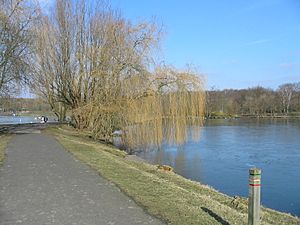Moses Gate Country Park facts for kids
Moses Gate Country Park is a large park and nature reserve. It covers about 750 acres (300 hectares)! You can find it near Bolton, England. Part of the park is also called Crompton Lodges. It's a special place where nature is protected.
Contents
Exploring Moses Gate Country Park
Moses Gate Country Park follows the River Croal. This river later joins the River Irwell. The park's name, "Moses Gate," comes from old words. "Moses" means marshy or boggy land. "Gate" means a way or path across. So, it means "the way through the marshy lands."
Crompton Lodges and Water Fun
The park is also known for its lakes, called Crompton Lodges. These lakes used to be mill ponds. They supplied water to old paper mills. Today, there are three main lodges:
- One lodge is used for fishing.
- Another is for water sports, like canoeing.
- The third lodge is a nature reserve. It's a quiet place for birds and other wildlife. Many migratory birds visit this lodge.
The park is part of the Kingfisher Way. This walking path is about 11 kilometers (7 miles) long. It stretches from Clifton Country Park to Jumbles Reservoir.
The Manchester, Bolton and Bury Canal
To the east of the lodges, you can see a part of the Manchester Bolton & Bury Canal. This section still has water in it. The land around here used to be old mine workings. One of them was called Farnworth Bridge Collieries. A weir was built in the River Croal. This helped supply water to Crompton's Paper Mill.
A Look Back: History of the Park Area
The area around Moses Gate has a long industrial past. It was once a busy place with factories and mines.
Early Paper Mills and Industry
One of the first paper mills in Lancashire was built here. The Crompton family started it in Farnworth. Robert Crompton began making paper here in the late 1600s. Later, Thomas Bonsor Crompton made the mill famous. It became a top place for making paper.
In 1828, the first steam weaving mill opened nearby. It later became a spinning mill. At Nob End, a chemical factory was built. The whole area also had many coal mines. These mines have all been closed and made safe now.
Changes Over Time
The paper mill eventually closed in 1883. This was during a time called the Great Depression. It reopened briefly as a bleach works. But it soon became empty again. The area fell into disrepair.
It wasn't until the mill was torn down in 1972 that people became interested in making it a park. Over the next ten years, the land was cleared. The area was transformed into the beautiful park you see today.
Rock Hall: A Historic Building
Rock Hall was built in 1807. It was built for John Crompton, Thomas Bonsor Crompton's father. John died around the time the house was finished. Later, managers of the paper mill lived there.
For many years, Rock Hall was the park's visitor center. It was also where the park rangers worked. The ranger service closed in 2014. The building is currently empty. However, the local council hopes to restore it in the future.
Nob End: A Special Nature Spot
Nob End is a very important part of the park. It was named a Site of Special Scientific Interest (SSSI) in 1988. It also became a Local Nature Reserve in 2000.
Unique Plants and Wildlife
The land at Nob End used to have a chemical works. Waste from this factory made the soil very alkaline. This special soil helps unique plants grow here. These plants are not found in many other places in Greater Manchester.
You can find many types of orchids at Nob End. Some of the most notable ones include:
- Fragrant orchid (Gymnadenia conopsea)
- Northern Marsh orchid (Dactylorhiza purpurella)
- Early Marsh orchid (Dactylorhiza incarnata)
Other interesting plants found here are Common Broomrape, Twayblade, Blue fleabane, and Carline thistle. This reserve covers about 8.8 hectares (21 acres). It's a wonderful place to see rare and beautiful plants.




